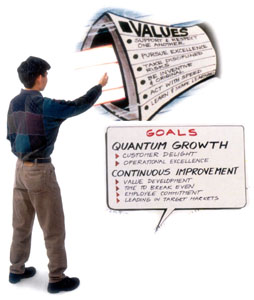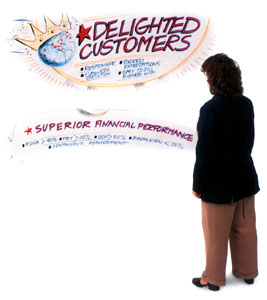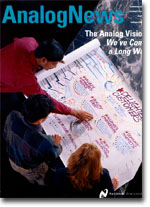
The Analog Vision
Analog News - February 1996 - National SemiconductorThe Analog Vision: Belief in the Power to Shape our Destiny
National's corporate values and Phase II of the transformation - which calls for quantum growth and continuous improvement - are linked with the Analog Group's Vision. Conceived in 1993, the Analog Vision is a comprehensive road map that shows where we've been, where we're going and how we intend to get there. And it's a set of aspirations that links with National's overall corporate values and Phase II business goals.
Our Phase II Corporate Business Goals and Values: What we need to accomplish as a company. In addition to corporate business objectives, the Analog Group is guided by a set of company values which are brought to life by our thoughts and actions on the job.
Our Analog Goals: What WE need to accomplish. Our own Analog Vision takes the company's Phase II goals and corporate values to a level of detail that is more directly related to what we wish to achieve in the analog business - customer delight and superior financial performance.
Essential Behaviors, Feelings and Attributes: Defining the culture of the Analog Group. If we follow the behaviors, feelings and attributes defined by the Analog Vision, we will create a successful business environment that cultivates customer delight and superior financial performance. Like the corporate values, these principles help guide the thoughts and actions of Analog employees worldwide.
Creating a Successful Business Environment: What the Analog Group aspires to. Achieving our ultimate goals of customer delight and superior financial performance will require profound change. Some changes are set forth in our ongoing redesign efforts. But we must also change by embracing the essential Vision elements that shape a successful business.
Looking Back at the Analog Vision: We've Come a Long Way
When the Analog Vision was created in June 1993 during the macro-design process, we were tasked with taking on challenges that seemed insurmountable. Every employee in the Analog Group was asked to change and adapt to a new set of beliefs, feelings and attributes. And the desired results that would define our culture differed dramatically from anything we had ever done.
This article was featured in Analog News. "At the time, the Analog Vision was considered a very radical change," says Graham Baskerville, Vice President of Analog Product Development Technology and a member of the macro-redesign team along with Barry Small, Vice President of Analog Value Delivery, Jim Thorburn, Vice President of Worldwide Finance and Mark Levi, Vice President of Analog Marketing. "Today, the Vision's beliefs, feelings and attributes are entrenched in everyone's minds and the results speak for themselves."
Graham noted that the Analog Group has done well in striving for its ultimate goal of superior financial performance and customer delight. "We met our financial goals within the first two years of the Vision, and by really applying ourselves, we surpassed them in fiscal year 1995. And customers are finding it easier to do business with us, which wasn't always the case."
According to Mark Levi, one of the most obvious changes from the macro-redesign was splitting the Analog Group into two divisions and 11 business units to provide a clearer focus on single and multimarket products. "In addition to changing our organizational structure, we redesigned Analog based on business processes, markets and products."
"We also wanted to change our culture and the way we thought about our business," adds Mark. "But before we changed, we had to take a hard look at ourselves, and I think that is where the most significant changes occurred. We're dramatically different from three years ago. We have a confidence in ourselves that wasn't there before and we're a much bigger force in the market."
Achieving The Impossible
During the Analog macro-redesign we asked ourselves a very difficult question: What would it take to bring the Analog Group from $500 million in sales to $2 billion in sales by fiscal year 1998?
"It seemed like an impossible goal at the time," recalls graham. Mark agreed, saying "We all thought it was unachievable. We knew we couldn't reach this goal by doing what we were doing. It would require dramatic change."
One change called for identifying and entering new emerging markets and making strategic acquisitions. "Unfortunately, we had no expertise in acquiring other companies and technologies," says Graham. "So the New Ventures organization was created within Analog."
Headed by Norm Miller, the New Ventures organization identified new opportunities for Analog that resulted in the acquisition of Comlinear, a maker of high-performance analog ICs. New Ventures was also instrumental in securing the rights from a consortium of broadcasters to develop a digital chipset that delivers CD quality sound to FM radios.
Prior to the macro-redesign, the Analog Group's financial target was $800 million in sales by fiscal year 1998. We surpassed this target in fiscal 1995, and are now on our way to reaching the $2 billion in sales by fiscal 1998. "I think we can achieve it," says Graham. "What seemed like an impossible goal at the time is within our reach."
"The Analog redesign has enabled us to realize that we can reach our aspirations, however lofty they might be," says Mark. "I think the Analog Group is well-equipped to face the most extreme challenges in the future because we've shown that we can change."





